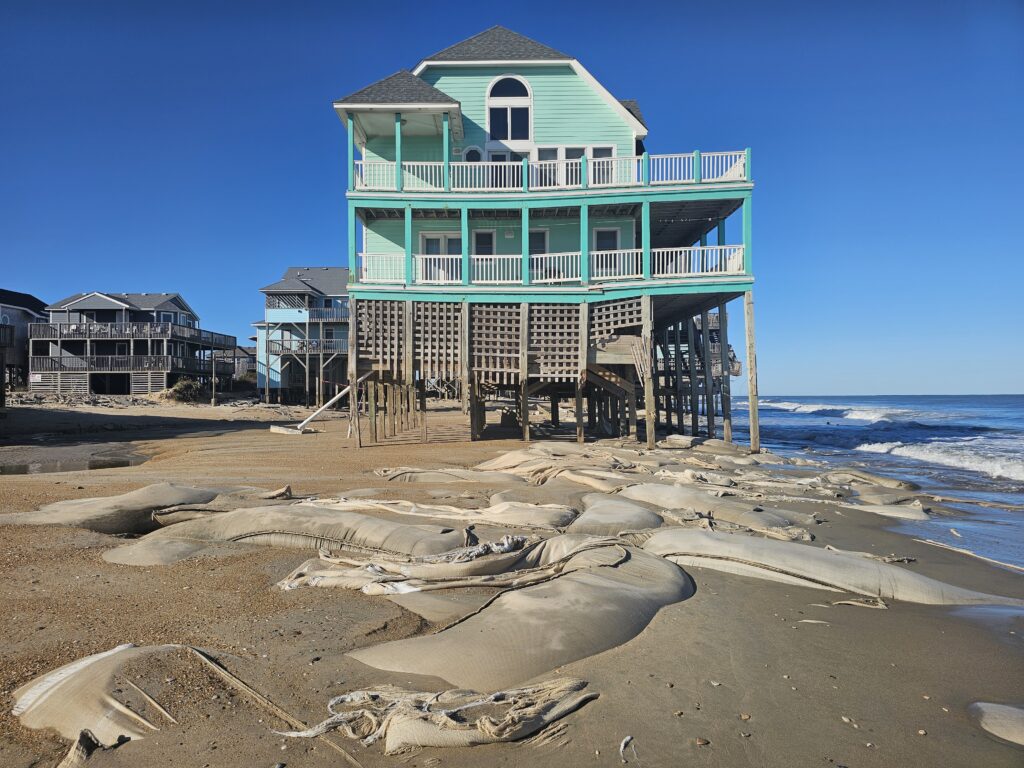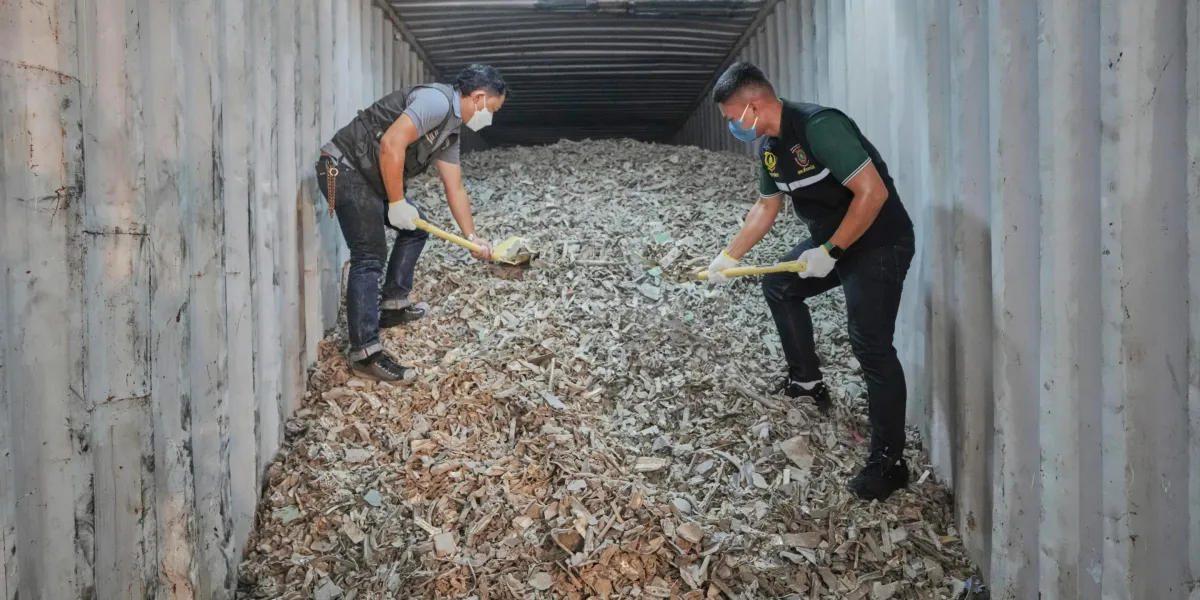Copyright Inside Climate News

The Outer Banks of North Carolina attracts more than 5 million visitors annually who prize this 200-mile stretch of islands as a Southern beach paradise. But as storms pound coastlines and sea levels rise, the pristine ocean and sprawling beaches that drew so many people to this tourist hotspot could now undermine it. Earlier today, a house collapsed on the shores of Buxton on Hatteras Island in Dare County, succumbing to rough tides as Hurricane Melissa brings choppy seas to the U.S. East Coast, despite the storm building most strongly more than a thousand miles away. This marks the twelfth home to collapse on Hatteras Island since mid-September. These structures were all compromised by strong tides, erosion and storm surge intensified by multiple recent offshore storms. It’s not a new problem for the Outer Banks or other areas along the U.S. East Coast, though data suggests it is happening more often. With hundreds more coastal North Carolina houses at risk, homeowners and the county must reckon with dwindling options for combating the issue. Swallowed by the Sea: As waves crash gently during low tide along the Buxton coastline of Hatteras Island, homes on the beach teeter precariously on wooden stilts. The structures show the scars of a near-constant battle against the sea; entire chunks are missing from wooden siding, windows are shattered and wires no longer attached to anything poke out from the sand. On one property, an air conditioner condenser unit swayed in the wind, connected to the home only by a few wires—stubbornly holding on like a loose tooth about to dislodge. Though seas were relatively calm last Thursday afternoon when my colleague Charles Paullin stopped by Buxton, it’s clear the rough tides brought by recent storms and offshore hurricanes—Melissa, Erin, Humberto and Imelda—have taken their toll. Drayton Blount, 34, of Virginia Beach, was staying further north in the Outer Banks in Kill Devil Hills last week. He stopped by the homes in Buxton that were bulldozed by the ocean. “For something like this to happen, it’s always tough,” Blount said. “It’s all part of living on the sandbar. It’s always shifting. Things are always changing.” Just five days later, the ocean claimed another home lining this stretch of beach. In the past five-and-a-half years, 23 privately owned houses have collapsed on the beaches of the Cape Hatteras National Seashore, 18 of those during 2024 and 2025. Blount is correct that this is a natural side effect of living on barrier islands, which are essentially highly mobile deposits of sand that move in response to dynamic weather and shifting seas. More frequent home collapses have occurred in the region since the early 2000s following a boom in housing development, and critical roads are often washed out or rendered unusable during storms. “These are not natural disasters. These are human disasters,” geologist Stan Riggs, who studied the coastline of this area for decades at East Carolina University, told me. “We knew 150 years ago how fast that shoreline is changing, and you do not want to put a house down there on the … leading edge of this energy system.” Research suggests that the risk is growing with climate change as warming ocean temperatures supercharge storms in the Atlantic Ocean, increasing the number of major hurricanes threatening the East Coast each year. This extreme weather can erode the sands that these houses rely on for their foundation, and more frequent rain events and storm surges leave little time for the beaches and dunes that protect homes to recover. In North Carolina, climate change has pushed up sea levels by about half a foot since 2000, William Sweet, an oceanographer with the National Oceanic and Atmospheric Administration, told The New York Times. Local governments are scrambling to combat erosion through multi-million-dollar beach nourishment projects, which involve adding sand manually to specific areas to extend the beach. But this process is only a short-term fix, according to Bobby Outten, Dare County’s manager and attorney. He said houses have been collapsing since he first moved to the area around four decades ago, but he recognizes that beaches are shrinking rapidly along the coast. In Buxton, “the erosion rate there has increased, or is faster than what we had anticipated,” he told me. “I do know that our [beach nourishment] project hasn’t lasted as long as we anticipated, hence having to do the project again next year.” In 2024, a group of federal, state and local officials—including Outten—released a report on managing threatened oceanfront structures, which found that 750 of nearly 8,800 oceanfront structures in North Carolina are at risk of oceanfront erosion. The majority of homes swallowed by the sea in the Outer Banks are secondary residences or vacation rentals. The report acknowledges that the issue “will inevitably worsen considering sea level rise forecasts,” but does not mention climate change at all in its 20 pages. This omission reflects the climate debates that emerge in the region each time a home collapses, as AFP reported on in September. Despite the growing body of research about the connection between climate change and erosion in the Outer Banks, Outten said that the county hasn’t waded into that discourse because “you get off message, because so many people have so many different points of view,” he said. “We’ve got to figure out how to solve these problems in a way that’s economical and efficient, to preserve our infrastructure, to preserve our economy and to protect the public,” Outten added, “and so that’s what our role in this is.” However, Riggs believes that climate change threatens the entire Outer Banks coastline. “It’s all about climate change,” he said. “It’s the climate that drives the storms, and the storms keep coming and [the] sea level is rising.” Hatteras Island is the epicenter for home collapses in the Outer Banks. The most affected villages are Rodanthe and Buxton. A Climate Paradox: Intense storms can rapidly reverse the progress of beach nourishment projects and sandbag barriers often stand little chance against major storm surge. Many of the homes at risk are also deemed unsuitable for use due to the damage they’ve already sustained, but the county does not have the legal authority to condemn them. That leaves the local government and the people who own at-risk homes with just a few options, each with downsides. People can dismantle their homes or relocate them, which is costly and comes with little government support. Or they can wait until the property is swallowed by the sea and claim the insurance money. That option may be better financially for the owners, but it poses environmental, economic and safety issues across the region when debris breaks off into the water and on the beach. While the Federal Emergency Management Agency’s National Flood Insurance Program does not cover the costs of relocating buildings, it does cover a large portion of the expenses associated with collapse for covered homes. The state and federal governments are exploring options for buyout programs to offer an alternative. In 2023, the National Park Service purchased two homes in the Rodanthe community of Dare County for more than $700,000 to tear down and convert to public beaches. However, this program didn’t have the funds to continue, despite further interest, The New York Times reports. In 2024, U.S. Rep. Greg Murphy (R-N.C.) introduced legislation to create a funding mechanism for relocating or removing structures, but it has stalled in the House. This means homeowners will likely get more money by waiting for a collapse than by using existing programs, according to Outton. “Property owners aren’t willing to sell for less than what they collect from their insurance if they allow it to fall in,” he said. “And local governments aren’t willing to buy for more than the fair market value, which is often less than the insurance coverage. And so you have some incentives that don’t line up there, and makes that difficult.” To avoid repeating the mistakes of the past when building new houses, Riggs said we need to “learn how to live with the coast,” instead of increasing construction on vulnerable lands. “The ocean does not negotiate,” he said. “And that’s what we have to remember.” More Top Climate News The Trump administration announced plans last week to open Alaska’s Arctic National Wildlife Refuge to oil and gas drilling, Maxine Joselow reports for The New York Times. The 1.56-million-acre swath of pristine coastal land is home to polar bears, musk oxen, moose, beavers and other animals, which experts say could be threatened by extractive activities. Since he entered office, President Donald Trump has repeatedly pushed for this step to support “American energy dominance.” While environmental groups decried the announcement, Alaska Native groups had varying reactions, with some supporting the economic benefits this move could provide. The administration also plans to allow construction of a gravel road through the Izembek National Wildlife Refuge in the state to support metal mining. An investigation from The Associated Press found that pregnant agricultural workers in the U.S. are facing rising threats from extreme heat, and many do not seek medical care in fear of retribution from their employers or the government, particularly if the workers are undocumented. Heat alone can cause miscarriages, premature birth, birth defects and other risks to both the child and parent. Combining these conditions with the exertion of physical labor can exacerbate the problem, especially when a pregnant person is dehydrated. The AP pointed to a tragic situation in 2008, when pregnant farmworker Maria Isabel Vasquez Jimenez died while pruning grapes in a California farm where supervisors did not give her adequate shade and water. My colleague Liza Gross has covered heat risks for farmworkers, if you’d like to learn more. California wildlife officers announced last week that they had uncovered “extensive evidence” linking a business in Los Angeles County to animal parts the government suspects were trafficked. Authorities seized at least nine rhino horns, thousands of pieces of elephant ivory, a sea turtle shell and several large, intricately carved tusks. The name of the business has not yet been revealed, but Nathaniel Arnold, California Department of Fish and Wildlife’s deputy director and chief of law enforcement, said in a press release that “these operations send a clear message that we will continue to hold accountable those who profit from the destruction of wildlife.” Postcard From … North Carolina This installment is from my colleague Charles, who visited the Outer Banks over the weekend for a fishing trip with friends. During his vacation, Paullin stopped by the area where the sea is buffeting at-risk homes. He took the above photo last Thursday. Earlier today, this home reportedly collapsed. “Hatteras Island is one of the most special places on earth to my friends and me,” he said. “The ocean’s mixing currents in the spring and fall make it a mecca for catching red drum, bluefish, Spanish mackerel and so much more, making their southbound and northbound migrations. It’s something we’ve done for years. We’ll continue to. Visiting the home destruction in Buxton was surreal. I’ve seen pictures of palm trees near the Hatteras Island’s point—the furthest eastward area where people can stand and use their fishing pole to heave their weights and baits to hook their bites. The trees are gone now. The point shrinks more and more every year. Just like the Buxton oceanfront the houses were built upon, including the area I was in last week that had another building collapse on it this morning.”



